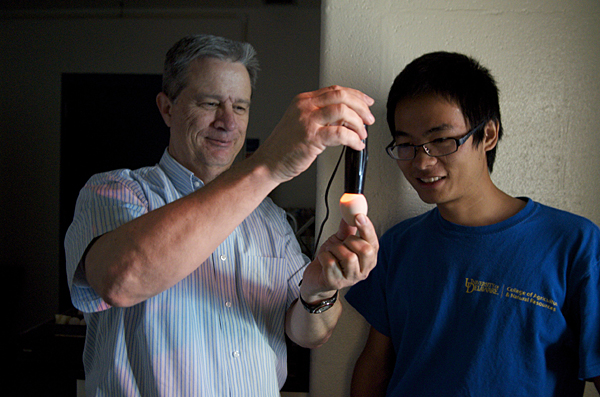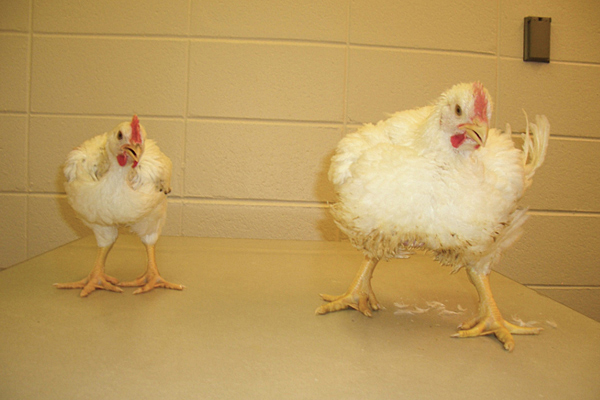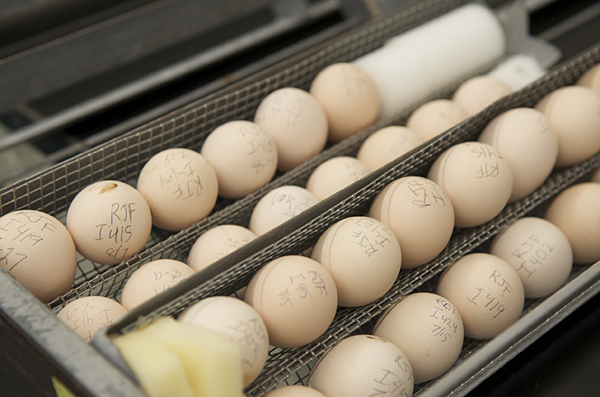


Chickens under stress
UD's Schmidt takes look back to study heat stress in poultry
9:52 a.m., Aug. 12, 2011--To help the chickens of the future, Carl Schmidt is looking to the chickens of the past. Schmidt, associate professor of animal and food sciences and biological sciences at the University of Delaware, has been awarded a grant to study heat stress on chickens -- both those that would have been around in the grocery stores of the 1950s and those that are found in supermarkets today.
Totaling $4.7 million, the five-year grant is funded through the Climate Change Initiative of the United States Department of Agriculture’s National Institute of Food and Agriculture (USDA-NIFA).
Research Stories
Chronic wounds
Prof. Heck's legacy
Schmidt said of the research, “The basic thought is that with climate change, it’s not so much the fact that the average temperature is going to go up a couple of degrees; it’s more the anticipation that there will be more heat waves, they will be hotter and they will last longer. And that is a problem for poultry production.”
By studying poultry from the 1950s, or “heritage” chickens, Schmidt is trying to see if any specific alleles -- or individual gene variances -- have been bred out of modern chickens that might make them less resistant to heat stress.
“Our hope is to identify particular alleles, variances in the population of genes, that help them survive heat stress. The thought is that if we can identify these alleles, industry could attempt to breed the alleles into their production lines,” he said.
The heritage chickens used by the University of Delaware in the study have been provided by the University of Illinois. In 1956, Illinois scientists set aside a male and female line of chickens and stopped selecting them for improved meat production. Those lines have been maintained, unselected, throughout the years, allowing researchers to study the chickens much as they would have been found in the 1950s.
One of the differences between the two types of chickens is that whereas the modern chicken goes to market in six weeks, the heritage bird would not go to market for 16 weeks. The modern chicken is also a lot larger than the heritage chicken.
Schmidt said, “Given the focus of this, we’re very curious, and we’ve really just started to ask the question: Do these birds response differently to heat stress?”
Explaining his research, Schmidt said, “We heat stress the birds and then we have a controlled population that we don’t heat stress. We then look at response and at gene expression patterns. We’re just doing our first trial but the heritage birds actually are using their drinker -- the implement from which they get water -- to get wet, whereas the modern chicken hasn’t used that yet.”
Two indicators that will help determine the two breeds’ levels of heat stress will be survival rate and production traits. “In many ways, since these are meat birds, breast muscle yield would be the thing really relevant to that," Schmidt said. "The anticipation would be that by having to deal with the heat stress, perhaps diverting energy into dumping heat or whatever, they don’t have the final production yields of the control birds.”
Schmidt also said that he is personally interested to see how human selection and evolution has impacted the various traits of the chicken. “How did selection pull out alleles of genes that for example made the breast muscle like three times bigger? That’s the kind of thing that really excites me.”
Schmidt is collaborating on the research with Susan Lamont and Max Rothschild from Iowa State University and Chris Ashwell from North Carolina State University.
In addition to the professors from other universities, students from UD will also help conduct the research. Those students involved include Janet de Mena, Schmidt’s associate and a UD graduate; Liang Sun, a doctoral student in animal sciences in the College of Agriculture and Natural Resources; and Shurnevia Strickland, a master's degree student in animal sciences.
Article by Adam Thomas
Photos by Danielle Quigley










